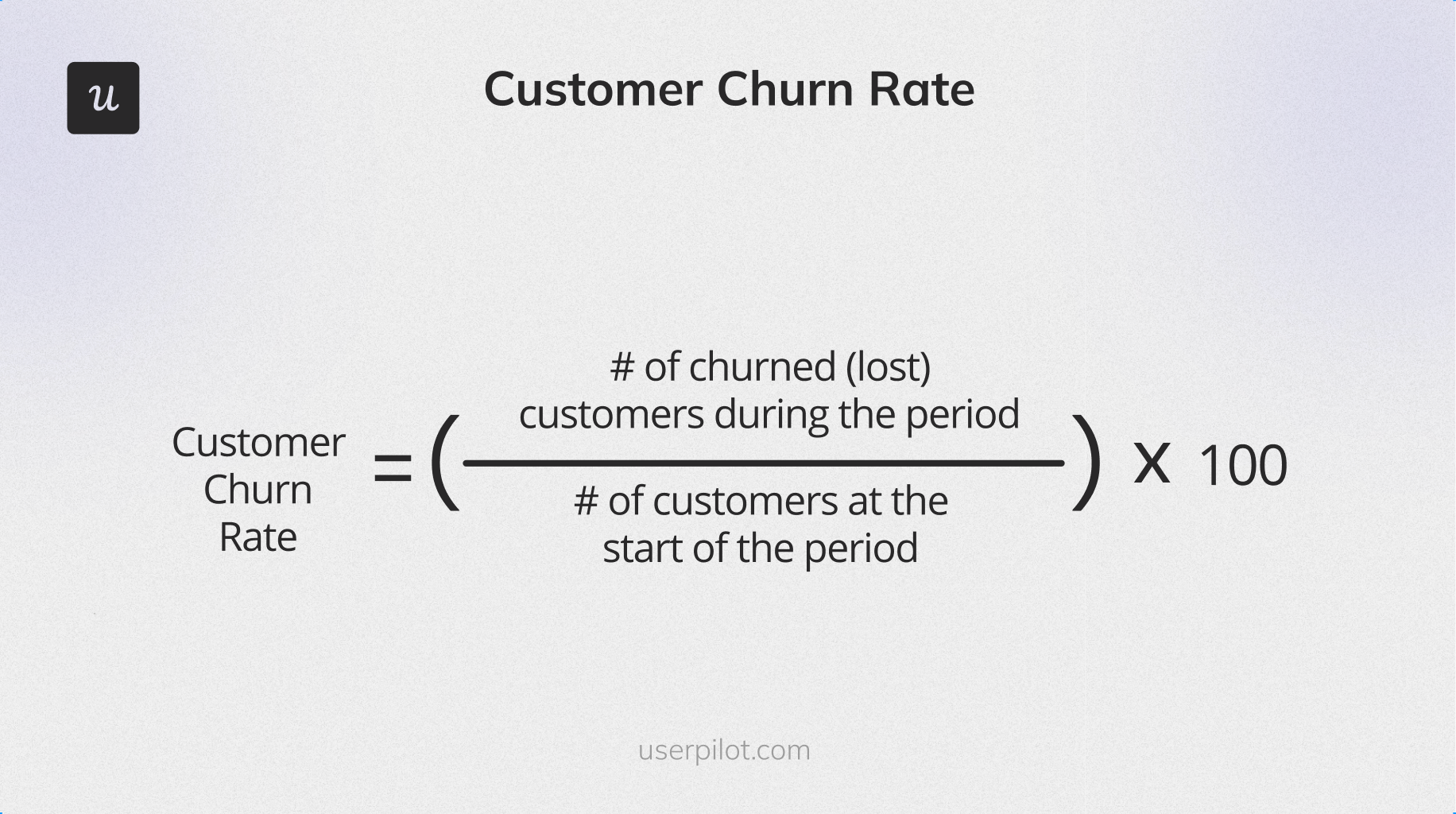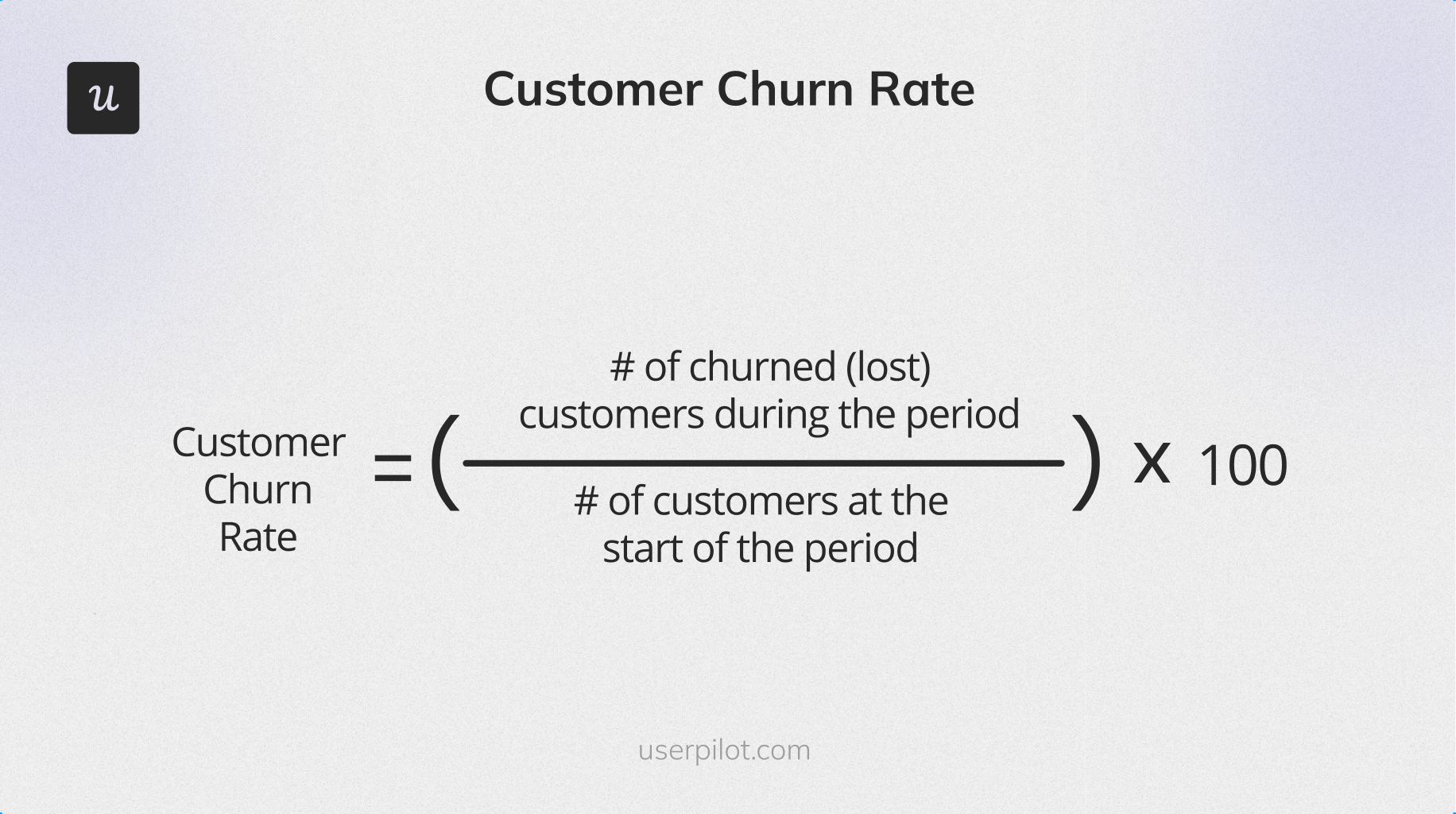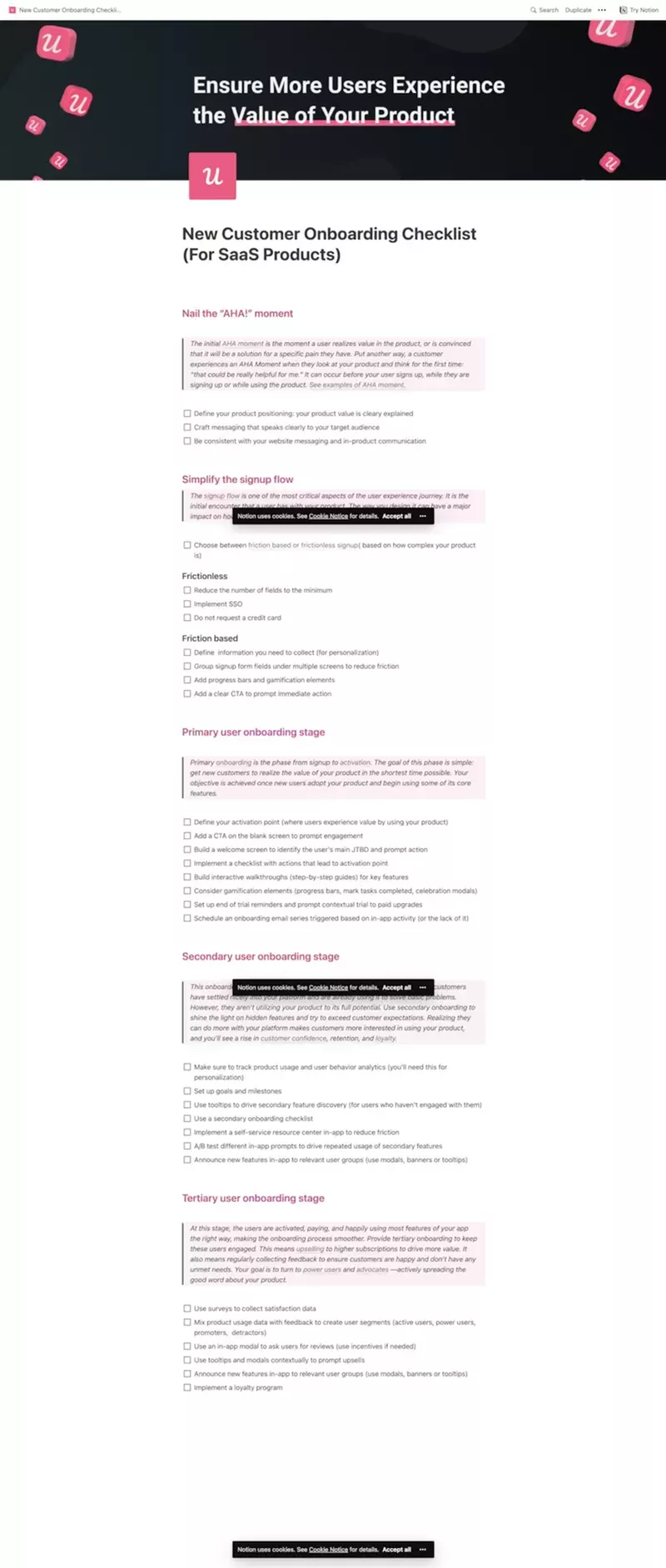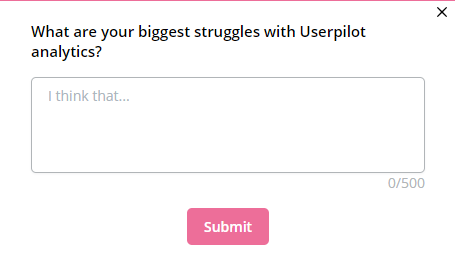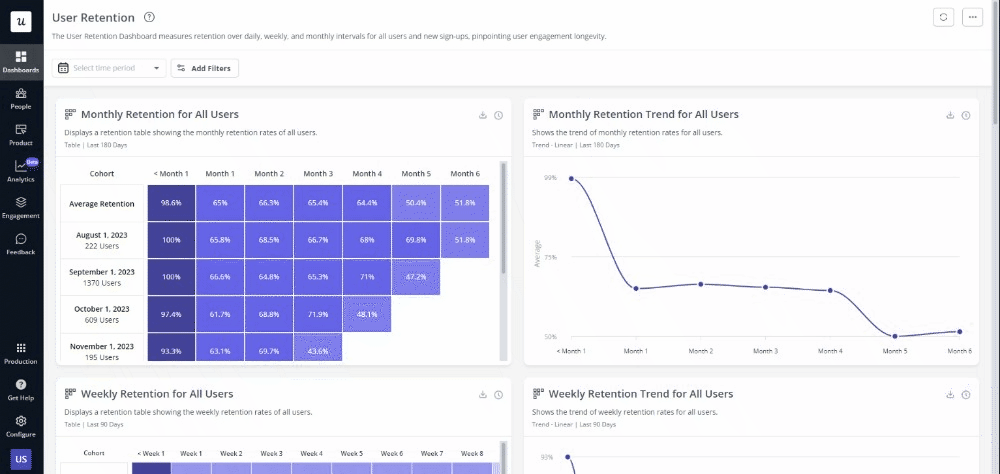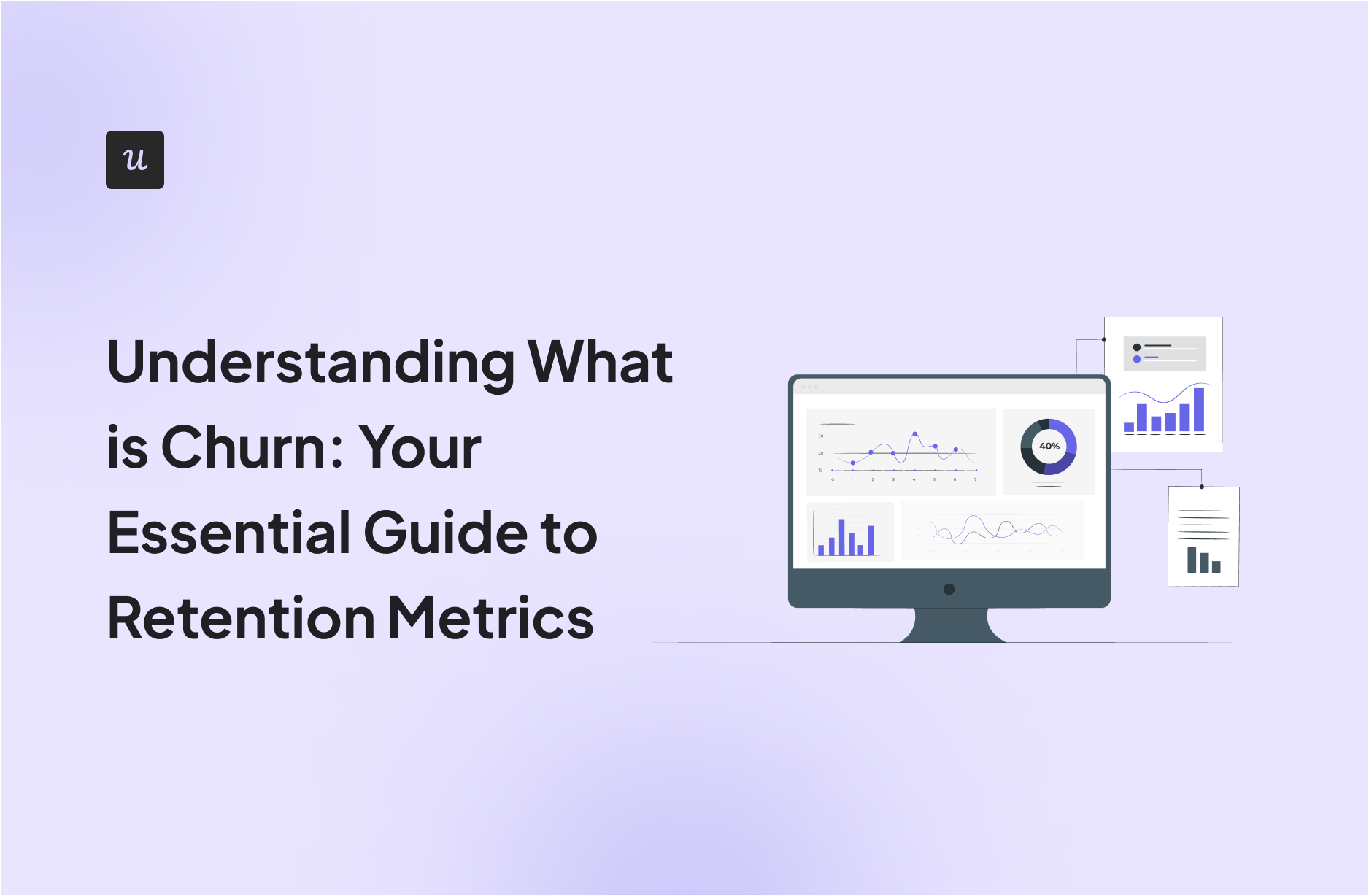
Understanding What is Churn: Your Essential Guide to Retention Metrics
What is churn? Simply put, churn measures how many customers businesses are losing over time — a central concern for companies dependent on customer retention, like those in the SaaS industry.
Additionally, the annual churn rate is a critical metric that quantifies the percentage of customers lost over a year, offering insights into long-term customer satisfaction and loyalty. This article will outline what churn is, demonstrate how to calculate it, and provide insight into effective churn reduction strategies, without overwhelming you with jargon or needless complexity.
Try Userpilot Now
See Why 1,000+ Teams Choose Userpilot

What is customer churn?
Customer churn in SaaS is the rate at which customers stop using a service within a set timeframe. It’s a key metric for assessing customer satisfaction and retention.
Understanding why customers churn is crucial for retention strategies. It involves examining both voluntary and involuntary churn, analyzing feedback, and balancing churn against growth rates for sustainability.
Churn reflects user engagement with a product, the value they find in it, and the effectiveness of retention efforts. A low churn rate suggests strong product-market fit and customer loyalty, whereas a high rate may indicate underlying issues with the product or service.
Defining customer churn rate
The churn rate quantifies the proportion of customers that either terminate or choose not to renew their subscriptions within a given time frame. This metric serves as an instantaneous gauge of a business’s ability to retain its customer base, and it also reflects how satisfied customers are with the company’s offerings.
These measurements can be taken on different schedules. Evaluating them monthly, quarterly, or annually is typical practice. By examining these rates over time, companies can glean important information regarding customer satisfaction and loyalty fluctuations.
Establishing benchmarks: Average churn rate across the industry
Grasping the significance of the churn rate is crucial, yet one must also weigh up the standard benchmarks within the industry. The norm for churn in the SaaS sector hovers around 13%, with an ideal target being below 3% per year. These statistics provide businesses with a benchmark to assess their own levels of customer retention.
Nevertheless, what qualifies as a satisfactory churn rate can differ markedly depending on various elements such as business model specifics, industry type, whether it’s B2B or B2C market-oriented, and even organizational scale. Companies that align their expectations by comparing themselves to competitors can better understand where they stand competitively and establish more achievable goals for minimizing churn rates.
Monthly churn rate: A closer look
The term “churn rate” often pertains to the monthly churn rate, which is an indicator of the proportion of customers who cancel their service within a month’s time. This statistic offers insightful data on how well a company retains its customer base and measures satisfaction within shorter intervals.
Take for example notable entities in streaming services: Netflix has identified its monthly churn rate at 3.3%, which when juxtaposed with Peloton’s reported figure of 1.41% or Apple TV+’s considerably higher churn at 15.6%, highlights the variability of customer turnover across different firms even when operating in analogous sectors.
Annual churn and its implications
The churn rate, when assessed on an annual basis, quantifies the percentage of customers a company loses over a year and offers insights into the effectiveness of long-term customer retention strategies. It is determined by taking stock of the customer count at the start and end of the year and expressing any decline as a fraction of initial numbers.
For companies in the Software as a Service (SaaS) sector, monitoring annual churn holds significant importance for understanding how well they are maintaining their client base. The data garnered from examining yearly churn rates informs strategic planning aimed at enhancing overall customer satisfaction and minimizing future losses or “churn” among users.
How to calculate customer churn: Churn rate formulas
To effectively manage and strategize for business growth, it’s essential to calculate churn rate, which provides a clear measure of customer turnover. Understanding how to calculate churn rate is crucial for businesses aiming to retain customers and minimize revenue loss. This process involves detailed steps and formulas to accurately determine the percentage of customers who have discontinued their services within a specific period, highlighting the direct impact of customer retention on revenue.
Churn rate, also known as customer attrition rate, can be determined through a variety of formulas. A fundamental method involves taking the number of customers who have left within a given period, dividing it by the total initial customer count, and then multiplying the result by 100 to find a basic churn percentage. This approach gives an easy-to-understand view of customer turnover. More complex calculations that take into account when exactly customers left and use average numbers might yield more intricate insights into churn.
On another note, revenue churn is tracked via the revenue churn rate metric which zeroes in on how much income has diminished as a consequence of lost customers during a specific time frame. It’s crucial for gauging not just how churn affects monetary aspects but also its implications for maintaining stable growth in terms of client base within SaaS companies—an indicator helpful in forecasting whether business-customer associations are likely to endure.
Simple churn rate calculation
To compute the churn rate, adhere to these steps:
- Ascertain how many customers were lost during a specific period.
- Take the number of customers lost and divide it by the initial total number of customers at the start of that period.
- To convert this figure into a percentage, multiply by 100.
Take, for instance, a scenario where you begin with 100 customers in one month, and within that same month, ten of those have ceased their relationship with your service. Thus, your churn rate is calculated as 10 divided by 100 which equals to 0.1 or expressed as a percentage: 10%. Posing the question can help grasp its significance: What quantity of customer loss corresponds to a churn rate of ten percent?
The comprehensive formula for calculating churn rates is: (Number of Customers Churned / Total Number Of Customers At The Period’s Commencement) x 100%. Applying this equation monthly yields insights into customer retention over more frequent intervals by assessing monthly churn rates.
Revenue churn rate: measuring financial impact
The revenue churn rate delves into the monetary impact of churn, unlike the basic churn rate which only accounts for the number of customers who have been lost. This metric is derived by taking the revenue that has dissipated from existing customers and dividing it by the total starting period revenue. This quotient is then magnified a hundredfold to yield a percentage.
For example, should there be a scenario where a company experiences a loss in earnings amounting to $100,000 from an initial sum of $1 million in revenues, we would observe a 10% revenue churn rate. Such an insight offers businesses more clarity on how much their financial health is affected due to customer departures and aids them in strategizing effectively to mitigate such losses and bolster their overall profitability.
Factors fueling customer churn in SaaS
Recognizing the causes of customer churn is crucial for devising successful approaches to reduce the churn rate. Key elements that lead to customer turnover, especially in SaaS businesses, include:
- Strategies related to pricing.
- Changing needs of customers.
- High levels of competition.
- Lackluster alignment with market demands.
Understanding customer acquisition costs is vital for SaaS companies, as high acquisition costs can significantly impact profitability and indirectly increase churn. Keeping acquisition costs in check is essential for maintaining business growth and reducing churn, as it alleviates the financial strain on the company and supports sustainable customer retention strategies.
Churn may also result from a discrepancy between what customers anticipate and what they experience regarding product functionality, which can stem from ambiguous communication or an incorrect understanding of the target consumer profile. When clients perceive that an alternative offering in the marketplace will more effectively meet their requirements, competitive forces can cause churn.
Strategies to minimize churn and boost retention
Addressing churn requires SaaS companies to adopt a forward-thinking and planned approach, with a key focus on improving customer experience to reduce churn. Implementing steadfast strategies such as ongoing product enhancement, refining pricing structures, providing outstanding customer assistance, and investing in tools and strategies to provide an outstanding customer experience is instrumental in diminishing churn while enhancing the longevity of the business’s health.
Embracing an attitude that places customers at the forefront is vital for success. Companies can markedly elevate customer satisfaction and improve the overall experience by deeply understanding customers’ needs, tailoring services and rewards accordingly, and fostering relationships via anticipatory interactions – all of which play a pivotal role in curbing churn. Additionally, emphasizing strategies designed to retain customers proves to be a cost-effective approach compared to acquiring new ones, highlighting the importance of developing long-term customer relationships to ensure company growth and financial health.
Enhancing the onboarding process for new customers
An effective onboarding process is key in mitigating initial customer churn by:
- Promptly demonstrating the benefits of your SaaS offering to newcomers.
- Helping new customers achieve their first successful outcome using your product.
- Observing for indicators of both success and potential issues as they get started.
This can markedly improve their early experience with the service.
Ensuring that customer support is readily available throughout this introductory phase lays a solid groundwork for sustained satisfaction and retention. Constant vigilance over user actions and input while they are being onboard facilitates ongoing enhancements to this critical stage, especially important as changes to the product occur.
Driving customer engagement for longevity
To reduce churn rates, it’s essential to interact with customers daily by providing personalized content that highlights product features, updates, and exclusive promotions. Engaging and informative materials like instructional blog posts on utilizing main functionalities and email newsletters packed with industry insights help maintain customer interest and awareness.
Studies highlight the significance of encouraging behaviors that enhance interaction with the product as this leads to better retention figures. Crafting a product that becomes an integral part of a customer’s workflow and evolves alongside their growth ensures ongoing involvement and helps preserve usage levels.
Leveraging customer feedback for continuous improvement
Maintaining a robust retention strategy and consistently monitoring how satisfied customers are enable businesses to take timely action based on customer feedback, which is instrumental in reducing churn rates. Being quick and effective when dealing with negative reviews is an integral part of the feedback loop that facilitates necessary enhancements while preserving customer loyalty.
Feedback sourced from those trying out products or services via free trials can be especially insightful for refining both offerings and approaches to keep clients. It’s important to concentrate efforts on:
- Swiftly fixing any service disruptions or product issues.
- Handling problems effectively.
- Reducing the adverse effects experienced by clients due to these issues.
- Enacting preventative measures against recurring challenges.
By honing in on these focal points and streamlining your costs related to customer acquisition, you bolster the chances of a favorable trial experience for users, thereby increasing their likelihood of transitioning into paying patrons. This approach not only ensures better client satisfaction, but also supports enduring consumer relationships.
From analysis to action: How successful SaaS companies manage churn
SaaS firms focus on scrutinizing customer data to ascertain satisfaction levels and tackle problems that will boost retention. For instance, HubSpot devised a ‘Customer Happiness Index’ which allowed them to measure the contentment of their users, take preventive measures against arising issues, and reclaim one-third of their discontented clientele.
Businesses such as Telefonica Ireland harnessed advanced analytics tools for a more profound comprehension of client conduct and concentrated their preservation strategies on customers who were already engaged. These instances underscore that through diligent analysis of data along with forward-thinking approaches can markedly diminish churn rates while augmenting the holding onto existing customers.
Tracking churn over time: Tools and techniques
Monitoring vital metrics such as:
- Customer Churn Rate.
- Revenue Churn Rate.
- Net Revenue Retention.
- Customer Lifetime Value.
It is crucial for SaaS companies to effectively handle customer attrition and understand where they stand in the market. Resources like CRM systems, analytic platforms, and specialized reporting dashboards—for instance, those provided by HubSpot—can assist in this endeavor.
Userpilot offers a potent solution for observing and deciphering user actions that can provide valuable insights to help enterprises minimize churn.
By leveraging these instruments and methodologies, companies can closely monitor churn trends and take preventive steps aimed at bolstering customer longevity.
Conclusion
In the competitive landscape of SaaS businesses, understanding and managing customer churn is paramount. From defining churn rates and establishing industry benchmarks to discussing strategies to minimize churn and boost retention, this guide has provided a comprehensive look into the importance of keeping churn rates low.
Remember, reducing churn isn’t just about retaining customers. It’s about creating a product and service that truly resonates with your customers, building strong relationships, and continuously striving to improve. Let’s turn churn into a chance to learn, grow, and succeed in the SaaS world.
Frequently asked questions
What is customer churn?
Customer attrition, often referred to as customer churn, signifies the rate at which customers cease their business relationships with a company. This metric is of paramount importance for SaaS businesses in monitoring the frequency with which they lose customers.
How is the churn rate calculated?
Churn, often expressed as a percentage, refers to the proportion of customers that a company has lost during a certain timeframe. It is determined by taking the number of customers who were lost in this period and dividing it by the total amount of customers at the start of that period.
What factors contribute to customer churn?
Understanding and addressing factors like pricing strategies, the evolution of customer needs, intense market competition, a poor fit between product and market, and discrepancies between what customers expect versus the actual capabilities of a product is vital to mitigate customer churn. Retaining customers hinges on this crucial awareness.
How can SaaS companies minimize churn and boost retention?
To enhance retention and diminish churn, companies providing Software as a Service (SaaS) should concentrate on persistent enhancement of their products, refine pricing strategies for optimization, deliver outstanding customer support, improve the process of onboarding new clients, stimulate ongoing customer engagement, and utilize feedback from customers to perpetually advance their offerings.
By implementing these tactics diligently, SaaS businesses can significantly elevate customer satisfaction and nurture loyalty, which is instrumental in reducing rates of churn.
What tools can help in tracking churn over time?
Employing CRM software, analytics platforms, reporting interfaces, and user behavior monitoring applications such as Userpilot enables effective tracking of churn across various time periods. These instruments assist in discerning trends that inform decision-making processes related to churn.

